|
|
|||
THIS WEEK at HILTON POND
1-7 November 2006
Installment #335---Visitor #
(Back to Preceding Week; on to Next Week)
|
WHEN IT'S DREARY AND COLD |
|
WHITE-THROAT,
YELLOW LORES In the Carolina Piedmont, it's hard to know just when seasons have transitioned from late summer to early fall or from autumn to winter. November temperatures often waver wildly from one day to the next at Hilton Pond Center, with frost at night followed by readings the next afternoon in the upper 70s. As anticipated, our first White-throated Sparrows of the fall appeared as November arrived at Hilton Pond. Our initial capture came on the fifth of the month--exactly the same day as our first one in 2005. Over the past quarter-century we HAVE had a significant influx of white-throats by mid-October--our earliest by far showed up on 4 October 1994--but most years the first week in November is a more reliable time to expect this migrant that breeds primarily in New England and southern Canada and spends winter in the southeastern and south central U.S.
All text & photos © Hilton Pond Center Beginning birders are often mystified by seemingly similar sparrow species that populate the back pages of their field guides. Folks who shy from the challenge of differentiating one sparrow from the next simply lump all of them as LBJs--"Little Brown Jobbers"--and go off to work on some less challenging group of birds. (HINT: If you think sparrows are hard, don't try to tackle confusing fall warblers, non-breeding shorebirds, or ducks in eclipse plumage.) Of all the sparrows, one of the easiest to identify is the white-throat, and a quick glance at the photo above shows you why; even though some birds carry bewildering monikers, the "White-throated Sparrow" is one species aptly named. Granted, a few other eastern LBJs have "white-throats"--the Swamp Sparrow is one--but the gular patch of the white-throat always has a dark line at its base, sharply delineating it from adjoining breast coloration.
All text & photos © Hilton Pond Center The White-throated Sparrow has another prominent field mark that easily separates it from most other sparrows. In fact, that particular characteristic--observable from almost any angle--could have provided the species with an alternate name: Yellow-lored Sparrow. "Lores" are the region of the face between the eye and the base of the upper bill; on White-throated Sparrows this area is always some shade of yellow (above).
All text & photos © Hilton Pond Center In young white-throats or those with especially pale (or dirty) plumage, the yellow may not be as noticeable as what shows in various photos on this page, but it is always present. (NOTE: A few other eastern U.S. sparrows have white throats and noticeable yellow lores--e.g., various races of Seaside and Savannah Sparrows--but in none of these is the lower edge of the throat patch edged by dark feathers.)
All text & photos © Hilton Pond Center And speaking of plumages, there is significant variation in external appearance even among white-throats. A relatively small percentage of any given population has plumage with glistening white eye lines contrasting with alternating black and white head stripes (above). Many more, especially in winter attire, are much drabber with pale white--even tan-colored--superciliary lines and head stripes that are brown or brownish-black (below). In the brighter morph all body coloration seems somewhat richer, while colors in the lighter, more common morph are much less intense. Contrary to popular belief and some field guides, these differences in color are not a reliable indicator of age or sex in White-throated Sparrows. These two distinctly different plumages are known as "polymorphism." Curiously, a breeding pair of White-throated Sparrows almost always consists of one bright morph parent and one pale morph. Field studies show that bright morph individuals are more aggressive but that pale morphs provide more care to nestlings and recent fledglings. Furthermore, females of both morphs appear to prefer pale males that may end up being better fathers, while males of both morphs tend to be attracted to brighter females that may defend the nest more aggressively.
All text & photos © Hilton Pond Center Since both males and females can be bright or drab, it's not possible to sex a White-throated Sparrow based solely on plumage. During breeding season the male will have a cloacal protuberance and the female a brood patch, but for most of the year the only external hint to a white-throat's sex is the length of its wing chord.
All text & photos © Hilton Pond Center One other field mark that will NOT help identify White-throated Sparrows is the pink color of their legs and feet (above). Virtually all our North American sparrows have such light-colored toes and tibiotarsi (lower legs), but in our experience the feet of white-throats are especially large--seemingly more adapted for scratching around in the soil than for perching.
All text & photos © Hilton Pond Center The White-throated Sparrow's scientific name is Zonotrichia albicollis, derived from root words that are definitely applicable. Its species epithet comes from terms meaning "white" and "neck," while the genus is from the Greek zone or "band" and trichos or "hair"--together referring to alternating bands of feathers on the bird's crown. The other eastern species in this genus is the White-crowned Sparrow, Z. leocophrys, with which bright-morph White-throated Sparrows are sometimes confused. Come spring, White-throated Sparrows that hang around Hilton Pond Center all winter disappear almost as suddenly as they showed up the preceding fall. Our latest lingering white-throat stayed until 27 May one year, a date by which we thought it should have been on its northerly nesting grounds. Up in New England, a softly whistled "Old Sam Peabody, Peabody, Peabody" is the mating tune guaranteed to attract attention of female white-throats, although north of the U.S. border these birds reportedly sing "Oh, sweet Canada, Canada, Canada." Regardless of national dialect, we sometimes hear the sweet song of this migrant around Hilton Pond--in the dead of winter and far, far away from places where it breeds.
All text & photos © Hilton Pond Center Now that November has arrived at the Center, we'll be listening every day for the "Sam Peabody" whistle of a White-throated Sparrow, confident its maker will be with us for the next several months. Even photographed somewhat fuzzily at long distance through double-paned window glass (above), this LBJ with white throat and yellow lores makes a pleasant picture, giving credence to early ornithologist Alexander Wilson's claim the it is "the handsomest of all our sparrows."
POSTSCRIPT: One might ask just what we mean when we say White-throated Sparrows are "far, far away" from where they breed. The best way we know to explain is to relate a sad story resulting from our bird banding work at Hilton Pond Center. Back on 15 April 1990 we caught an after-hatch-year white-throat of unknown sex in a trap outside our office window. We banded the bird and released it, thinking it was high time for a white-throat to be moving toward its breeding grounds. And move north it did. In fact, this speedy little bird moved at a fast clip, covering at least 970 straight-line miles in just two weeks. And how do we know this? Well, on 1 May 1990 this particular White-throated Sparrow was found dead at Lake à la Ligne in Quebec, Canada--right after it was killed by a free-roaming cat! Undoubtedly exhausted from its lengthy northward journey, our long-distance white-throat was easy prey for a non-native predator that had no business being in position to kill a migratory native songbird. Sad story indeed. All text & photos © Hilton Pond Center Comments or questions about this week's installment?
Thanks to the following fine folks for recent gifts in support of Hilton Pond Center for Piedmont Natural History and/or Operation RubyThroat: The Hummingbird Project. Your contributions allow us to continue writing, photographing, and sharing "This Week at Hilton Pond." (See Support if you'd like to make a gift of your own.)
"This Week at Hilton Pond" is written & photographed You may wish to consult our Index of all nature topics covered since February 2000. You can also use our on-line Hilton Pond Search Engine at the bottom of this page. For a free, non-fattening, on-line subscription to |

 Like most folks we follow the lead of astronomers and view the autumnal equinox on 22 September as the first day of fall, but we never accept that all our Ruby-throated Hummingbirds are gone and winter is close until White-throated Sparrows start frequenting our feeders. In the words of John James Audubon, whose white-throat rendering with Flowering Dogwood blossoms is at right: "How [the white-throated finch] comes and how it departs are to me quite unknown. I can only say, that, all of a sudden, the edges of the fields bordering on creeks or swampy places, and overgrown with different species of vines, sumach bushes, briars, and the taller kinds of grasses, appear covered with these birds."
Like most folks we follow the lead of astronomers and view the autumnal equinox on 22 September as the first day of fall, but we never accept that all our Ruby-throated Hummingbirds are gone and winter is close until White-throated Sparrows start frequenting our feeders. In the words of John James Audubon, whose white-throat rendering with Flowering Dogwood blossoms is at right: "How [the white-throated finch] comes and how it departs are to me quite unknown. I can only say, that, all of a sudden, the edges of the fields bordering on creeks or swampy places, and overgrown with different species of vines, sumach bushes, briars, and the taller kinds of grasses, appear covered with these birds."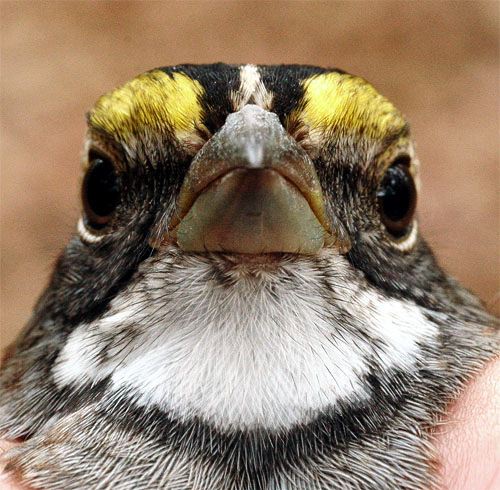
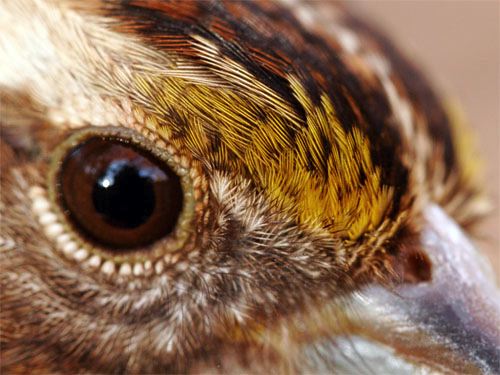



 If this measurement--the distance along a relaxed wing from the bird's wrist to the tip of its longest primary feather (left)--is 67mm or less, the bird is almost certainly a female. If the wing chord is greater than 74mm, the bird is a male. One problem is that in the 67mm-74mm range, birds can be either male or female; since 90-95% of white-throats fall within the overlap, even a bander with birds-in-the-hand seldom knows for sure a white-throat's sex. (NOTE: Wing chord is a standard measurement taken by bird banders. In some sexually monomorphic species it can be used to differentiate male from female, but in most cases there is so much overlap the great majority of birds must be sexed as "unknown." Obviously, the birds themselves know their sex, but we humans can't tell just by looking or measuring.)
If this measurement--the distance along a relaxed wing from the bird's wrist to the tip of its longest primary feather (left)--is 67mm or less, the bird is almost certainly a female. If the wing chord is greater than 74mm, the bird is a male. One problem is that in the 67mm-74mm range, birds can be either male or female; since 90-95% of white-throats fall within the overlap, even a bander with birds-in-the-hand seldom knows for sure a white-throat's sex. (NOTE: Wing chord is a standard measurement taken by bird banders. In some sexually monomorphic species it can be used to differentiate male from female, but in most cases there is so much overlap the great majority of birds must be sexed as "unknown." Obviously, the birds themselves know their sex, but we humans can't tell just by looking or measuring.)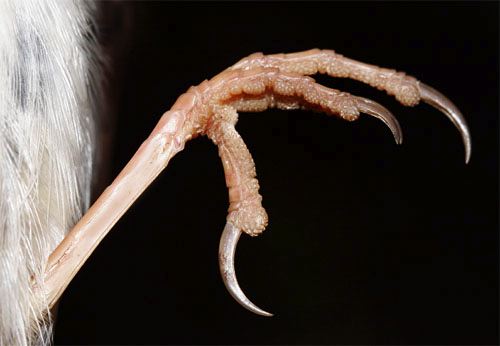
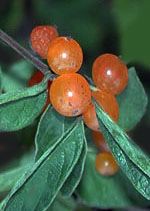 In fact, white-throats are primarily ground-feeders that claw up weed seeds and small invertebrates that serve as their winter staple. They also eat significant numbers of dogwood berries and buds of apple, maples, and oaks. It's these assorted plant parts that provide carotene and xanthophyll pigments the white-throat absorbs and then lays down within its yellow lores. One White-throated Sparrow we caught a few years ago (below) had lores in a burnt orange tint rather than bright yellow; we suspect it had been dining up north on berries of non-native Tatarian Honeysuckle (above right) or possibly Pyracantha as it brought in new facial feathers.
In fact, white-throats are primarily ground-feeders that claw up weed seeds and small invertebrates that serve as their winter staple. They also eat significant numbers of dogwood berries and buds of apple, maples, and oaks. It's these assorted plant parts that provide carotene and xanthophyll pigments the white-throat absorbs and then lays down within its yellow lores. One White-throated Sparrow we caught a few years ago (below) had lores in a burnt orange tint rather than bright yellow; we suspect it had been dining up north on berries of non-native Tatarian Honeysuckle (above right) or possibly Pyracantha as it brought in new facial feathers.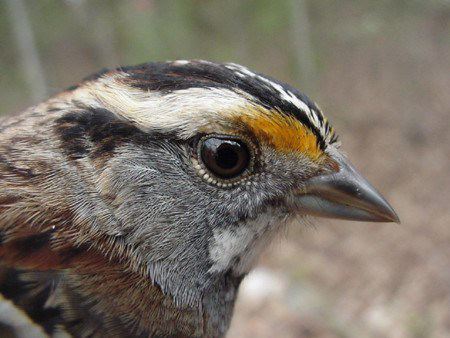
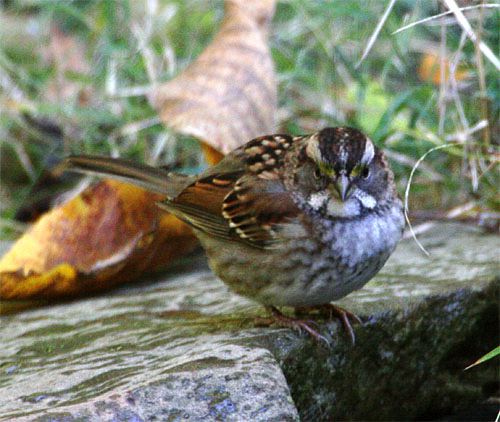


 Please report your
Please report your Oct 15 to Mar 15
Oct 15 to Mar 15
